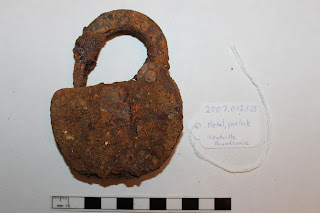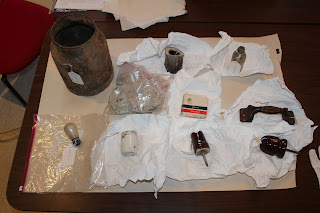Cleaning Ceramics
With the assessment of the roundhouse objects completed and approval from the curator to proceed the next step is to do the cleaning. I have concentrated on ceramics in the first phase of cleaning. In general the ceramics are part of the railway dining car sets that were broken or disfigured and then thrown away. The cleaning is done in several steps as follows by using:
- a stiff brush such as a smaller art painting brush to brush away the loose material,
- a wooden pick with a sharp point such as a shish-kabob stick to dislodge dirt from crevices,
- a tooth brush to dislodge any more stubborn material,
- a soft cloth dipped in soapy, distilled water to wipe off stains, soil,
- a second soft cloth to rinse with distilled water.
Conservation Tip: Be very careful when cleaning to avoid any damage to the makers mark or a registration number often found on the bottom of ceramics such as cups, bowls or plates. It is best to avoid these to ensure that they will remain readable. This is also true for all historical objects with any identifying marks such as the owner's initials, signature, and so on which can be found in paper, cloth, leather, glass, and so on. Any loss of readability is to be avoided since the marks often assist in determining dates, history of use, owner, and/or maker of an object. The ceramics we cleaned had identifying marks which we left alone as shown in the photograph below. The makers mark in this case was applied before it was glazed and fired so it is stable but the registration number was added later and is somewhat fragile.
Photographs are taken of all objects before and after with a scale and a label to record the removal of material. All work is done using gloves and on a base of plastic to control moisture. The soap is the same one used to clean mouldy textiles - Orvus. In all cases we were able to remove most of the soil and what looked like rust stains. Some would not come off with minor amount of pressure so were left as is. Below are photographs showing before and after with this type of cleaning. Please note that only a small amount of material was removed in this example as found around the outside edge of the base and around the handle while some of the red marks also came off.
 |
| Makers mark in the centre Registration number in black ink below it |
 |
| Ceramic cup before cleaning |
 |
| Ceramic cup after cleaning with soil bits removed shown on lower right |


















